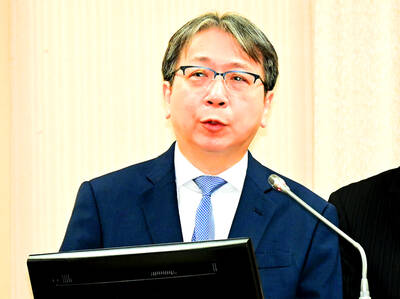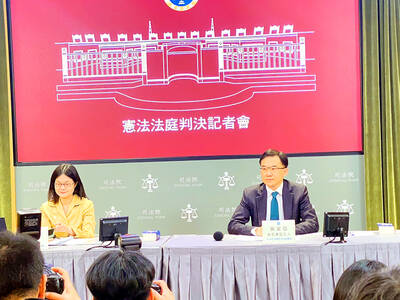Despite warming cross-strait ties, the government does not rule out the possibility of China launching an all-out attack on Taiwan in response to political developments across the Taiwan Strait or to achieve its ultimate goal of unification, according to the Ministry of National Defense’s latest analysis on the military capability of the People’s Liberation Army (PLA).
The report, which has been submitted to the legislature for review, said there is a strong possibility that China would resort to military force to achieve unification once its objective of enhancing its combat capability to a level sufficient for a general invasion of Taiwan is fulfilled by 2020.
However, as China does not yet possess the capability to do this because of its lack of amphibious transport vehicles, it could, for some time yet, remain dependent on intimidation, blockades and threats of artillery barrages should the cross-strait situation deteriorate, the report said.
It said such approaches would aim to create panic in an attempt to coerce Taiwan’s government into suing for peace.
“Once China paralyzes our army, it might instantly mount a triphibious attack on Taiwan and take control of the country before any parties could have a chance to intervene,” the report said.
The PLA has clearly not scaled down its military ambitions toward Taiwan and has continued preparations for an invasion, the report said, citing China’s military drills last year that featured simulated attacks on Taiwan and its navy’s training missions near the Bashi Channel, as well as in the seas off the eastern and northeastern coasts of the country.
Turning to the PLA’s Second Artillery Force, the report said that the tactical ballistic and cruise missiles the force has deployed across the Strait threatens much of the country and have the ability to precisely hit individual targets.
“Additionally, the force has developed its Dong Feng-21D medium-range ballistic missiles that are designed to destroy aircraft carriers and prevent a third party from intervening in the event of a cross-strait military conflict,” the report said.
Worries over a possible Chinese invasion of Taiwan were also expressed in a US Department of Defense report on the Chinese military released on May 7, which said that “there have been no signs that China’s military disposition opposite Taiwan has changed significantly” and that “the PLA has developed and deployed military capabilities to coerce Taiwan or to attempt an invasion, if necessary.”
The National Security Bureau has also expressed concerns over massive cyber attacks from China.
“The bureau was hit by 76,371 and 57,779 unsuccessful cyber attacks last year and in the first half of this year respectively,” the bureau said. “Luckily, these malicious assaults were caught and blocked in time.”

The US government has signed defense cooperation agreements with Japan and the Philippines to boost the deterrence capabilities of countries in the first island chain, a report by the National Security Bureau (NSB) showed. The main countries on the first island chain include the two nations and Taiwan. The bureau is to present the report at a meeting of the legislature’s Foreign Affairs and National Defense Committee tomorrow. The US military has deployed Typhon missile systems to Japan’s Yamaguchi Prefecture and Zambales province in the Philippines during their joint military exercises. It has also installed NMESIS anti-ship systems in Japan’s Okinawa

TRAGEDY STRIKES TAIPEI: The suspect died after falling off a building after he threw smoke grenades into Taipei Main Station and went on a killing spree in Zhongshan A 27-year-old suspect allegedly threw smoke grenades in Taipei Main Station and then proceeded to Zhongshan MRT Station in a random killing spree that resulted in the death of the suspect and two other civilians, and seven injured, including one in critical condition, as of press time last night. The suspect, identified as a man surnamed Chang Wen (張文), allegedly began the attack at Taipei Main Station, the Taipei Fire Department said, adding that it received a report at 5:24pm that smoke grenades had been thrown in the station. One man in his 50s was rushed to hospital after a cardiac arrest

ON ALERT: Taiwan’s partners would issue warnings if China attempted to use Interpol to target Taiwanese, and the global body has mechanisms to prevent it, an official said China has stationed two to four people specializing in Taiwan affairs at its embassies in several democratic countries to monitor and harass Taiwanese, actions that the host nations would not tolerate, National Security Bureau (NSB) Director-General Tsai Ming-yen (蔡明彥) said yesterday. Tsai made the comments at a meeting of the legislature’s Foreign Affairs and National Defense Committee, which asked him and Minister of National Defense Wellington Koo (顧立雄) to report on potential conflicts in the Taiwan Strait and military preparedness. Democratic Progressive Party (DPP) Legislator Michelle Lin (林楚茵) expressed concern that Beijing has posted personnel from China’s Taiwan Affairs Office to its

‘ILLEGAL RULING’: The KMT and the TPP slammed the Constitutional Court judgement, saying it contravened the law and was trying to clear the way for a ‘green dictatorship’ The Constitutional Court yesterday ruled that amendments to the Constitutional Court Procedure Act (憲法訴訟法) passed by the Legislative Yuan last year are unconstitutional, as they contravene due legislative process and separation of powers. The Legislative Yuan on Dec. 20 last year passed amendments stipulating that no fewer than 10 grand justices must take part in deliberations of the Constitutional Court, and at least nine grand justices must agree to declare a law unconstitutional. The Executive Yuan on Jan. 2 requested that lawmakers reconsider the bill, but the Legislative Yuan, under a combined majority of Chinese Nationalist Party (KMT) and Taiwan People’s Party